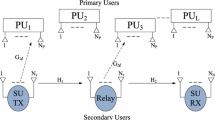Abstract
In this paper, we demonstrate the performance analysis of an underlay MIMO cognitive radios employing space time block coding at secondary’s user transmitter (SU-Tx) and generalized selection combining at secondary’s user receiver. The transmit power strategy enforces the SU-Tx to adapt its power to be transmitted so as to protect primary user’s receiver from harmful interference in order to satisfy primary user outage constraint. We derive closed form expressions for average post processing signal to noise ratio and ergodic capacity. Moreover, approximate expression for average bit error rate is also obtained. Based on the achieved results, we show that the average post processing SNR, Ergodic Capacity and average BER improve as number of best branches to be combined increases. Finally analytical results are affirmed through Monte Carlo simulations.




Similar content being viewed by others
References
Mitola, J., & Maguire, G. Q. (1999). Cognitive radio: Making software radios more personal. IEEE Personal Communications, 4(6), 13–18.
Akyildiz, I. F., Lee, W. Y., Vuran, M. C., & Mohanty, S. (2006). Next generation dynamic spectrum access cognitive radio networks: A survey. Computer Networks. doi:10.1016/j.comnet.2006.05.001,2127-2159.
Khoshkholgh, M. G., Navaie, K., & Yanikomeroglu, H. (2010). Access strategies for spectrum sharing in fading environment: Overlay, underlay and mixed. IEEE Transactions on Mobile Computing, 9(12), 1780–1793.
Ghasemi, A., & Elvino, S. S. (2007). Fundamental limits of spectrum sharing in fading Environments. IEEE Transactions on Wireless Communications, 6(12), 649–658. doi:10.1109/TWC.2007.05447.
Kang, X., Liang, Y. C., Garg, H. K., & Zhang, R. (2009). Optimal power allocation for fading channels in cognitive radio networks: Ergodic capacity and outage capacity. IEEE Transactions on Wireless Communications, 8(12), 940–950.
Kang, X., Zhang, R., Liang, Y. C., & Garg, H. K. (2011). Optimal power allocation strategies for adding cognitive radio channels with primary user outage constraint. IEEE Journal on Selected Areas in Communications, 29(2), 374–383.
Alamouti, S. M. (1998). A simple transmit diversity technique for wireless communications. IEEE Journal on Selected Areas in Communications, 16(8), 1451–1458.
Eng, T., Tong, N., & Milstein, L. B. (1996). Comparison of diversity combining techniques for Rayleigh fading channel. IEEE Transactions on Communication, 44(9), 1117–1129.
Alouini, M. S., & Simon, M. K. (2000). An MGF based performance analysis of generalized selection combining over Rayleigh fading channels. IEEE Transactions on Communications, 48(3), 401–415.
Zummo, S. A. (2008). Performance of coded systems with generalized selection diversity in nakagami fading. EURASIP Journal on Wireless Communications and Networking. doi:10.1155/2008/670503.
Xiaodong, C., & Georgios, B. G. (2004). Performance analysis of combined transmit selection diversity and receive generalized selection combining in Rayleigh fading channels. IEEE Transactions on Wireless Communications, 3(6), 1980–1983.
Tarokh, V., Jafarkhani, H., & Calderbank, A. R. (1999). Space-time block codes from orthogonal designs. IEEE Transactions on Information Theory, 45(5), 1456–1467.
Zeng, X. N., & Gharayeb, A. (2004). Performance bounds for space-time block codes with receive antenna selection. IEEE Transactions on Information Theory, 50(9), 1456–1467.
Li, W., Beaulieu, C., & Chen, Y. (2009). Generalized receiver selection combining schemes for Alamouti MIMO systems with MPSK. IEEE Transactions on Communications, 57(6), 1599–1602.
Lee, D., & Jang Jeong, B. (2013). Performance analysis of scheduled cognitive radio systems with MIMO transmission. IEEE Transactions on Vehicular Technology, 62(8), 4088–4093.
Kong, A. H. Y. (2011). Ergodic and outage capacity of interference temperature limited cognitive radio multi-input multi-output channel. IET Communications, 5(5), 652–659.
Vu, M., Devroye, N., Sharif, M., & Tarokh, V. (2007). Scaling laws of cognitive networks. In Proceedings of international conference cognitive radio oriented wireless networks and communications (Crowncom) (pp. 2–8). doi:10.1109/CROWNCOM.2007.4549764.
Duan, R., & Elmusrati, M. S. (2014). Performance analysis of a cognitive-shared channel with GSC diversity under primary outage probability. In International conference on computing, networking and communication (pp 83–87)
Hung, T, Hans, J. Z., & Chan Dai, T. T. (2013). Outage performance of cognitive radio networks under outage constraint of multiple primary users and transmit power constraint of secondary user. In International conference on ubiquitous and future networks (ICUFN) (pp. 631–635). doi:10.1109/ICUFN.2013.6614895.
Simon, M. K., & Alouni, M. S. (2005). Digital communication over fading channels (2nd ed.). New York: Wiley.
Perez, J., Ibanez, J., Vielva, L., & Santanmaria, I. (2005). Closed-form approximation for the outage capacity of orthogonal STBC. IEEE Communication Letters, 9(11), 961–963.
Soon, Tan Beng, Tan, Kwok Hung, & The, Kah Chan. (2012). Performance analysis of orthogonal space time block code with minimum selection generalized selection combining receiver over Rayleigh fading. IEEE Transactions on Vehicular Technology, 61(3), 1463–1467.
Gradshteyn, I. S., Ryzhik, I. M., Jeffery, A., & Zwillinger, D. (2007). Table of integrals, series and products (7th ed.). Amsterdam: Elsevier.
Acknowledgement
This research work was supported by Technical Education Quality Improvement Programme (TEQIP) phase II, Government of India.
Author information
Authors and Affiliations
Corresponding author
Rights and permissions
About this article
Cite this article
Bindra, K.V., Sharma, S. & Khanna, R. Performance Analysis of Combined Space Time Block Coding with Generalized Selection Combining in Underlay Cognitive Radio. Wireless Pers Commun 95, 2561–2573 (2017). https://doi.org/10.1007/s11277-016-3934-0
Published:
Issue Date:
DOI: https://doi.org/10.1007/s11277-016-3934-0




